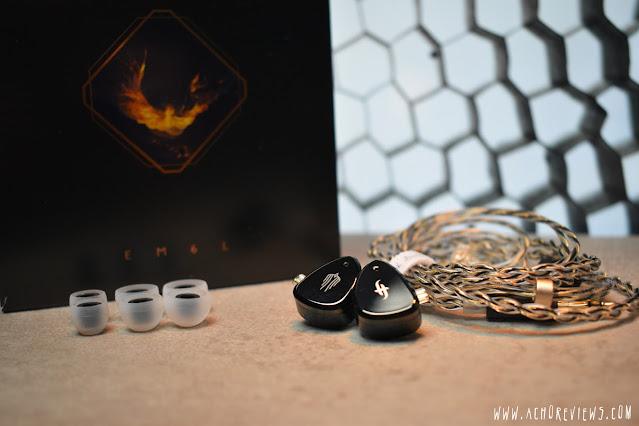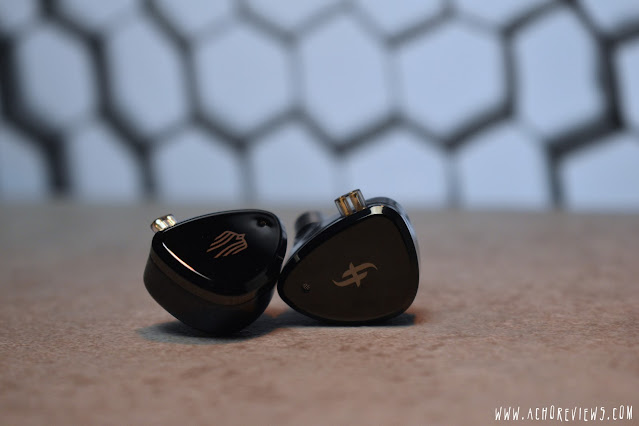- Get link
- X
- Other Apps
English | Español
TLDR version on YouTube: TDLR - Simgot EM6L
The EM6L have been sent to me directly by Simgot in exchange for the publication of my thoughts and opinions in this review. Simgot have not made any specific requests and, as always, I will try my best to be as unbiased as possible.
You can find the official page for the Simgot EM6L here: http://www.simgot.com/en/products/detail/30.html
As always, this is a non-affiliate link.
To avoid being repetetive in my reviews, you can find all the info about how I create the reviews, equipment used, how I receive the products and how to interpret my reviews by visiting: About my reviews
Intro…
The Simgot EM6L are a hybrid set of IEMs that feature an 8mm dynamic driver paired with 4x balanced armature drivers and a 3 way crossover. They come in at just over the 100€ mark and are said to be tuned towards the H-2019 target.
Those of you that are in the IEM world will automatically know what the H-2019 target is and probably also know if it is something you favour or not.
For those of you that have no idea what it is, it is basically the preference curve that Harman released in 2019 based on their research, which, according to them, should be favourable for the majority of the population. I am not going to go into details about the target, nor my opinion of it, so let’s get on with the important part, the EM6L.
Presentation…
The EM6L comes nicely packaged in a rather elegant box with a picture of a phoenix in flames on the front, with a logo of a phoenix on the interior box that slides out sideways. The back of the box shows the frequency response graph of the IEMs, along with a dissection of them and specifications beneath.
Inside the main box, at the top sit the IEMs in a rigid foam cut out, with an accessory box below and a box for the eartips underneath the IEMs.
As far as accessories, we get the cable, 3 sets of sillicone tips in 3 sizes, a semi rigid storage/transport case and the user manual.
There is nothing really extraordinary about the contents, they are a little sparse to be honest, but they do come well packaged and presented.
Build and aesthetics…
The IEMs are simple yet elegant, in a shiny black finish that uses a resin shell together with what seems to be an aluminium face plate, featuring the Simgot logo in a sort of titanium colour in the center, with a small ventilation hole beneath. They don’t scream “look at me” and they don’t look cheap either, as I said, they are elegant in their simplicity.
They are also compact and quite lightweight. I found that they fit me comfortably (which is obviously only relevant to me) and did not cause any kind of fatigue even when wearing them for long listening sessions.
I am also a fan of the aesthetics of the included cable. Again it is simple, just a plain twist that divides into single cores after the split but the cables are soft a malleable, with a nice choice of black and an “almost” gold colour. One thing to note is that the use the recessed 2 pin connectors on the cable, which means that if you want to change the cable, you will need to take this into consideration but I really don’t see any need to not stick with the cable that is included as it is rather nice (unless you need balanced).
Sound…
All tracks mentioned are clickable links that allow you to open the reference track in the streaming service of your choice (YouTube, Tidal, Qobuz, Spotify, etc.)
I already mentioned in the intro that these IEMs are tuned to follow the Harman 2019 curve but let’s take our usual look at the graph and see how this tuning looks in comparison to my usual personal preference curve for reference.
I haven’t said it yet this year, maybe because this is only the second review, but my preference curve is just a basic reference, it is not a rule that determines whether I will like something or not. There are many times when I enjoy things that deviate from it and other times that I don’t enjoy models that are actually close to it in tuning.
Now let me share my usual comments when using my test track list that I always refer to when doing a final detailed listening test of whatever I am trying out (the full list can be found here).
To not break tradition, starting off with the subbass ranges and my obligatory test of “Chameleon”, there is plenty of rumble for my tastes and while the subbass is fairly clean, I find that the additional presence of midbass, which I will get to next, does subtract a little from the clarity and impressiveness of the lows in this set.
If we move to “No Sanctuary Here”, there is quite a punchy response to the midbass, again fairly clean and detailed, yet, with this track having a little more focus on the midbass, it does overshadow the lowest of notes slightly. The result is satisfying and I think it will please those who like a little more emphasis on these ranges but personally I would have preffered slightly less midbass, leaving the subbass to shine a little more.
Things are well controlled and pretty clean moving into the lower mids, with no muddyness or sensation of things being out of control. My usual midbass fatigue test with “Crazy” does show them to be a little too present in the reverb of the lower notes but not enough to actually cause fatigue, which is a very positive thing.
There is a slight lack of presence in the midrange on occasions, such as with the vocals in the track “No Sanctuary Here” that I just mentioned but it is not enough to make things sound distant, it more of a slight focus on the lows and highs rather than any absence of mids. The upper mids do climb slightly later than I am usually fond of but again, it does not affect presence of vocals, mainly due to the rather energetic higher upper mids and treble in general.
Now, I just said “energetic” upper mids and treble, yet it is not in your face. In fact, the treble, while noticeably present, still manages to be smooth and non fatiguing. I had measured these IEMs before spending time with them and based on the graph, I would have expected a much more fatiguing and harsh upper ranges than they actually deliver.
The extension is fairly decent, although not really amazing, but it is how they manage to stay focused and smooth that is the surprising part for me. My test of sibilance with “Code Cool” would place sibilance around neutral for what I have come to expect from the track. The same could be said for Lana Del Rey in “Hope Is A Dangerous Thing”, where sibilance is not reduced but is not exaggerated (which is good, because it is already quite hot in the recording).
Soundstage is not huge yet the EM6L provides a slightly holographic sensation to the sound. Not holographic as in it is being affected by distortions or giving a false sensation, more of just a slight extension of presence around vocals that makes them seem lusher and fuller.
As far as detail, they are not something that is going to blow your mind by allowing you to hear the creaking of a chair in the back of the room but they do a decent job and do not seem to try and over emphasize things to the point of pretending they are what they really aren’t.
Conclusion…
The tuning of the EM6L is not my personal preference, however, I have to say that they do a very coherent job of it and, as I just said, don’t pretend to be something that they aren’t. I think the thing that surprised me the most is how the treble manages to be present but smooth and relaxed at the same time. There are many sets of IEMs, especially with BA’s, that can come across in these upper ranges as trying to be impressive but only end up being fatiguing. That is not the case here, in fact, they don’t try to be impressive and are pretty impressive in doing so.
If you are someone who favours the Harman tuning, then I think that these IEMs can give you many hours of non fatiguing joy. The included accessories may not be up to the level of some of the competitors in this price range but, in the end (to me at least), it is the performance in the ears that matters.
All FR measurements of IEMs can be viewed and compared on achoreviews.squig.link
All isolation measurements of IEMs can be found on achoreviews.squig.link/isolation
To comment or contact, visit any of the following social media platforms:







